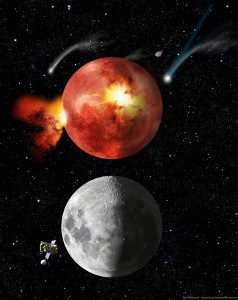
An artist’s depiction by Tim Wetherell, of the Australian National University
(Click to enlarge.)
And, of course, the Earth wasn’t far away, astronomically speaking. Meteors struck it, too.
The new (March 2015) issue of Scientific American contains an interesting article by two UCLA planetary scientists, David Jewitt and Edward D. Young.
“Oceans from the Skies” looks at the current state of the question “Where did Earth’s water come from?”
There’s a two-paragraph preview available here that might whet your appetite or, at least, cause you to look at your glass of water, and the ocean, and your nearby stream or lake, just a bit differently:
The argument persists: Did our oceans come from comets, or from asteroids — that is, from the same sorts of planetesimals that formed Earth in the first place — or, perhaps, from terrestrial encounters with dwarf planets such as the still-surviving Ceres, which, at a width of 900 kilometers, is the largest “asteroid” in our solar system?
Interesting factoid: Earth is remarkably dry.
“Many people,” write Jewitt and Young, “are surprised to learn that . . . ocean water constitutes only about 0.02 percent of the mass of Earth. Put another way, if our planet was a 300,000 kilogram Boeing 777, then all the water in the oceans would have the mass of a single passenger. Freshwater locked up in polar ice caps, clouds, rivers, lakes, soil and Earth’s biota contributes only a tiny fraction to this total. . . . As strange as it may seem, in actuality, Earth is some 100 times drier than old bone.”











